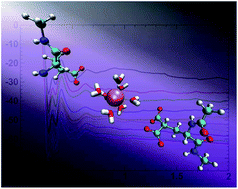Improving the description of interactions between Ca2+ and protein carboxylate groups, including γ-carboxyglutamic acid: revised CHARMM22* parameters†
Abstract
A reliable description of ion pair interactions for biological systems, particularly those involving polyatomic ions such as carboxylate and divalent ions such as Ca2+, using biomolecular force-fields is essential for making useful predictions for a range of protein functions. In particular, the interaction of divalent ions with the double carboxylate group present in γ-carboxyglutamic acid (Gla), relevant to the function of many proteins, is relatively understudied using biomolecular force-fields. Using force-field based metadynamics simulations to predict the free energy of binding between Ca2+ and the carboxylate group in liquid water, we show that a widely-used biomolecular force-field, CHARMM22*, substantially over-estimates the binding strength between Ca2+ and the side-chains of both glutamic acid (Glu) and Gla, compared with experimental data obtained for the analogous systems of aqueous calcium–acetate and calcium–malonate. To correct for this, we propose and test a range of modifications to the σ value of the heteroatomic Lennard–Jones interaction between Ca2+ and the oxygen of the carboxylate group. Our revised parameter set can recover the same three association modes of this aqueous ion pair as the standard parameter set, and yields free energies of binding for the carboxylate–Ca2+ interaction in good agreement with experimental data. The revised parameter set recovers other structural properties of the ion pair in agreement with the standard CHARMM22* parameter set.


 Please wait while we load your content...
Please wait while we load your content...